Last year an area of forest the size of Italy was destroyed, in large part to clear land for raising cattle destined for human consumption. The majority of trees were felled in the Amazon and the Democratic Republic of Congo.
Deforestation records began in 2001. Since then only one year has been worse than 2017, and that was the year before. Numbers crunched by MFM in 2016 showed that an area of rainforest the size of a hundred football pitches was being cut down every hour, specifically to develop land to raise livestock. Overall, a portion of land the size of Spain was cleared of trees in 2016.
Last year, a total of 113,000 square miles of forest were cleared for beef production as well as growing other traded commodities, such as soy and palm oil. For comparison’s sake, Italy is 116,000 square miles in area, New Zealand 104,000 square miles and the UK 93,000 square miles. Thirty per cent of tropical rainforest loss took place in Brazil, which alone lost 17,000 square miles of trees, while the rate of deforestation in Colombia reached record levels, with 1.2 million acres of forest lost, an astonishing rise of 46 per cent on 2016.
The figures were produced by Global Forest Watch, an online monitoring platform run by the US non-profit World Resources Institute that uses satellites to monitor changes in global tree cover. Deforestation currently accounts for a tenth of global carbon emissions – that’s because rainforests play a vital role in absorbing carbon emitted by humans, and release all their stored carbon when they are cut down and burnt or left to rot.
Frances Seymour, a senior fellow at the WRI said that “tropical forests were lost at a rate equivalent to 40 football fields per minute” last year, adding: “Vast areas continue to be cleared for soy, beef, palm oil and other globally traded commodities. Much of this clearing is illegal.” Global attempts to curb deforestation, he said, were like “trying to put out a house fire with a teaspoon”.
A 2015 report by the Overseas Development Institute found that international aid to help countries such as Brazil and Indonesia protect their rainforests is dwarfed by the amount those countries spend on subsidising industries that destroy rainforests. As well as meat and livestock farming, they include growing palm trees for palm oil, timber logging and producing soy.
A 2012 report highlighted the link between meat eating and deforestation when its authors, the Union of Concerned Scientists, showed that much of new land for meat production has come from clearing tropical rainforest to create super-sized cattle ranches. Given that it takes 10kg of grain to produce 1 kg of beef, it would better if current farmland were used more wisely, by growing crops to feed humans instead.
Livestock farming accounts for twice as much deforestation as the soy, palm oil and timber industries combined. Conservation scientists in South America say that between 1990 and 2005, beef cattle production was the cause of 71 per cent of deforestation on the continent; the figure for other commodity farming, including sugar, rubber, coffee and cocoa, was just 17 per cent.
